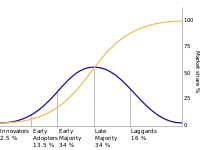
Photo from wikipedia
PurposeThis study aims to determine barriers to innovation and to develop a quantitative model for the barrier to innovation in Vietnamese construction organizations of different sizes.Design/methodology/approachA literature review and discussions… Click to show full abstract
PurposeThis study aims to determine barriers to innovation and to develop a quantitative model for the barrier to innovation in Vietnamese construction organizations of different sizes.Design/methodology/approachA literature review and discussions with experienced practitioners were implemented to determine barriers to innovation in construction organizations. The rank-based non-parametric test analyzed collected data from a questionnaire survey to examine if there were significant differences between the three groups of organizations, including small, medium and large construction organizations. The fuzzy synthetic evaluation (FSE) technique was employed to develop barrier indexes (BIs) for organizations of different sizes in Vietnam.FindingsThe findings showed 17 barriers to innovation which were categorized into four groups, including organizational, human resources, economic and market barriers. Statistical analysis revealed significant differences regarding barriers to innovation between small, medium and large construction organizations in Vietnam. The post hoc test highlighted barriers to innovation differently separated into two groups: SMEs and large construction organizations. The FSE analysis integrated the identified barriers into the comprehensive BIs for SMEs and large construction organizations. The FSE analysis illustrated that the organizational barrier is the most critical barrier for SMEs. On the other hand, the market barrier received the most significant attention in large construction organizations.Originality/valueThis research is one of the first integrated barriers to innovation into a comprehensive formulation. The indexes provide the decision-makers with a practical and reliable tool to evaluate barriers to innovation in construction organizations of different sizes.
Journal Title: Engineering, Construction and Architectural Management
Year Published: 2023
Link to full text (if available)
Share on Social Media: Sign Up to like & get
recommendations!